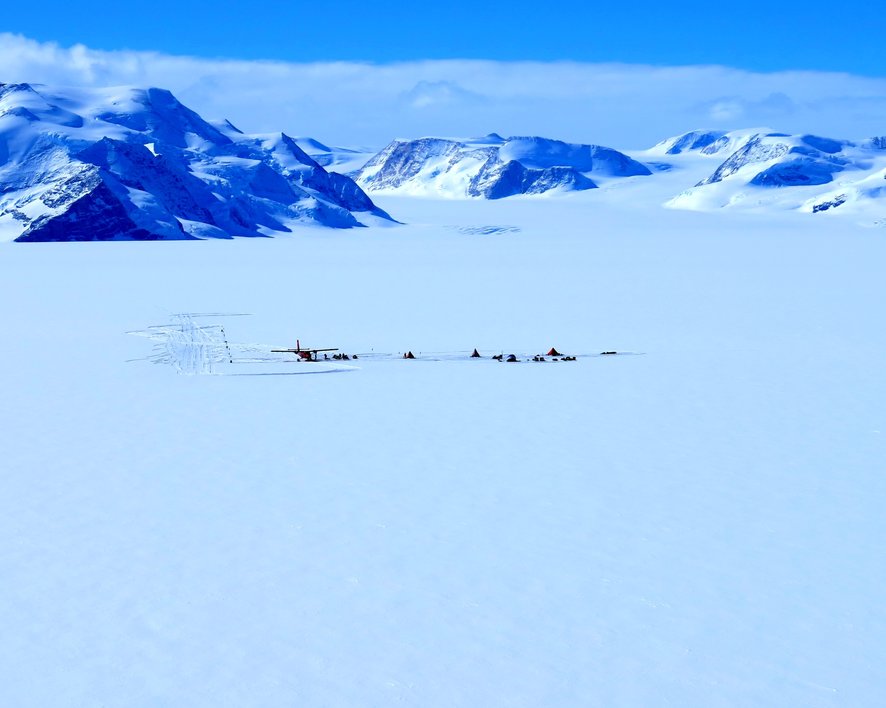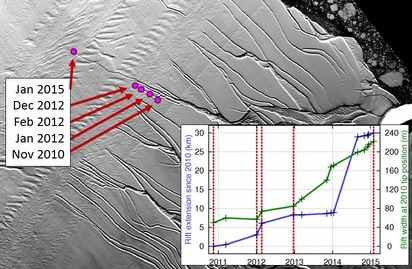1) Bevan, S., L., A. J. Luckman, P. Kuipers Munneke, B. Hubbard, B. Kulessa and D. Ashmore. ASCAT scatterometer data reveal declines in Larsen C ice shelf surface melt accompany 21st century Antarctic Peninsula cooling. Earth and Space Science, in press.
(2) Kuipers Munneke, P., A. J. Luckman, S. L. Bevan, C. J. P. P. Smeets, E. Gilbert, M. R. van den Broeke, W. Wang, C. Zender, B. Hubbard, D. Ashmore, A. Orr, J. C. King, and B. Kulessa (2018). Intense winter surface melt on an Antarctic ice shelf. Geophysical Research Letters, 45, doi.org/10.1029/2018GL077899
(3) Bevan, S. L., A. J. Luckman, B. Hubbard, B. Kulessa, D. Ashmore, P. Kuipers Munneke, M. O’Leary, A. D. Booth, H. Sevestre and D. McGrath. 2017. Centuries of intense surface melt on Larsen C Ice Shelf. The Cryosphere, 11(6), 2743-2753, doi:10.5194/tc-11-2743-2017.
(4) Chester, M. L., B. Kulessa, A. J. Luckman, J. N. Bassis and P. Kuipers Munneke. 2017. Systems Analysis of complex glaciological processes and application to calving of Amery Ice Shelf, East Antarctica. Annals of Glaciology, 58(74), 60-71, doi:10.1017/aog.2017.1.
(5) Ashmore, D., B. Hubbard, A. J. Luckman, B. Kulessa, S. L. Bevan, A. D. Booth, P. Kuipers Munneke, M. O'Leary, H. Sevestre and P. R. Holland. 2017. Ice and firn heterogeneity within Larsen C Ice Shelf from borehole optical televiewing. Journal of Geophysical Research: Earth Surface, 122(5), 1139-1153, doi:10.1002/2016JF004047.
(6) Kuipers Munneke, P., D. McGrath, B. Medley, A. J. Luckman, S. L. Bevan, B. Kulessa, D. Jansen, A. D. Booth, P. Smeets, B. Hubbard, D. Ashmore, M. Van den Broeke, H. Sevestre, K. Steffen, A. Shepherd and N. Gourmelen. 2017. Observationally constrained surface mass balance of Larsen C ice shelf, Antarctica. The Cryosphere 11(6), 2411-2426, doi:10.5194/tc-11-2411-2017.
(7) Hubbard, B., A. Luckman, D. Ashmore, S. Bevan, B. Kulessa, P. Kuipers Munneke, D. Jansen, M. O’Leary and I. Rutt. 2016. Massive subsurface ice formed by refreezing of ice-shelf melt ponds. Nature Communications, 7, 11897, doi: 10.1038/ncomms11897.
(8) Jansen, D., A. J. Luckman, A. Cook, S. Bevan, B. Kulessa, B. Hubbard and P. R. Holland. 2015. Brief Communication: Newly developing rift in Larsen C Ice Shelf presents significant risk to stability. The Cryosphere, 9, 1223–1227, doi:10.5194/tc-9-1223-2015.
(9) Luckman, A., A. Elvidge, D. Jansen, B. Kulessa, P. Kuipers Munneke, J. King, and N. E. Barrand. Surface melt and ponding on Larsen C Ice Shelf and the impact of foehn winds. Antarctic Science, 26(6), 625-635, doi:10.1017/S0954102014000339.
(10) Kulessa, B., D. Jansen, A. J. Luckman, E. C. King, and P. R. Sammonds. 2014. Marine ice regulates the future stability of a large Antarctic ice shelf. Nature Communications, 5:3707, doi: 10.1038/ncomms4707.
(11) Jansen, D., A. J. Luckman, B. Kulessa, P. R. Holland, and E. C. King. 2013. Marine ice formation in a suture zone on the Larsen C Ice Shelf and its influence on ice shelf dynamics, Journal of Geophysical Research – Earth Surface, 118, 1–13, doi:10.1002/jgrf.20120.
(12) Luckman, A., D. Jansen, B. Kulessa, E. C. King, P. Sammonds and D. I. Benn. 2012. Basal crevasses in Larsen C Ice Shelf and implications for their global abundance. The Cryosphere, 6, 113-123, doi:10.5194/tc-6-113-2012.
(13) King, M. A., L. Padman, K. Nicholls, P. Clarke, H. Gudmundsson, B. Kulessa, A. Shepherd, and N. Gourmelen. 2011. Ocean tides in the Weddell Sea: new observations on the Filchner-Ronne and Larsen C ice shelves and model validation. Journal of Geophysical Research – Oceans, 116, C06006, doi: 10.1029/2011JC006949.
(14) Jansen, D., B. Kulessa, P. R. Sammonds, A. Luckman, E. C. King, and N. F. Glasser. Present stability of the Larsen C ice shelf, Antarctic Peninsula. Journal of Glaciology, 56(198), 593-600, doi:10.3189/002214310793146223 (October 2010).


